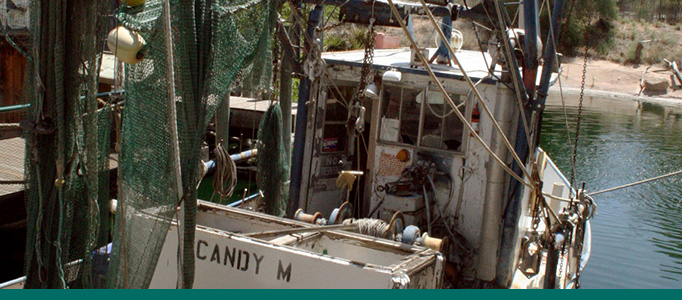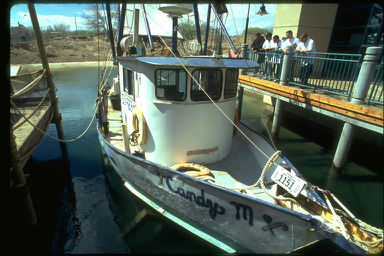Working on the Water

When Visiting...
- See New Mexico's only registered shrimp boat, the Candy M, harbored just outside the Gulf Coast Gallery.
- Learn about shrimping in the Gulf of Mexico.

The Candy M is a steeled-hulled bay shrimper from Ingelside, Texas, now harbored in the Aquarium to give guests a glimpse at the life of a shrimper. This boat represents both the culmination and decline of a 230 year-old tradition along the Gulf Coast.
Shrimp boats in the Gulf of Mexico operate either in the open gulf or in the bays. Ranging over wide geographic areas, "Gulf" shrimpers often remain at sea for several days. Inshore shrimpers ("bay" shrimpers) net either high-quality shrimp or bait shrimp and return home each day with their catch.
Originally considered unmarketable catch, shrimp eventually developed a reputation as high-class seafood.
Until the 1920s, shrimping and other fisheries in the Gulf of Mexico remained small, with fairly minor impacts on marine ecosystems. Improved technologies, including refrigerating and canning catches, resulted in engines replacing sails and trawls replacing muscles.
Altogether, bay shrimpers in the Gulf of Mexico sell about 13 million pounds of white shrimp each year worth an estimated $20 million.
During spring, each boat crew can dock up to 600 pounds of catch daily and work from dawn until 2 p.m. Crews can also catch all day long in autumn. Summer shrimping is prohibited, except for bait shrimping in designated bays. Some areas also allow night shrimping in winter.
Our Actions Matter
Although shrimping is an age-old profession, overfishing and other environmental changes are damaging underwater ecosystems everywhere. By making simple choices, we can help reduce overfishing and preserve natural marine ecosystems for future generations. Learn more here.
